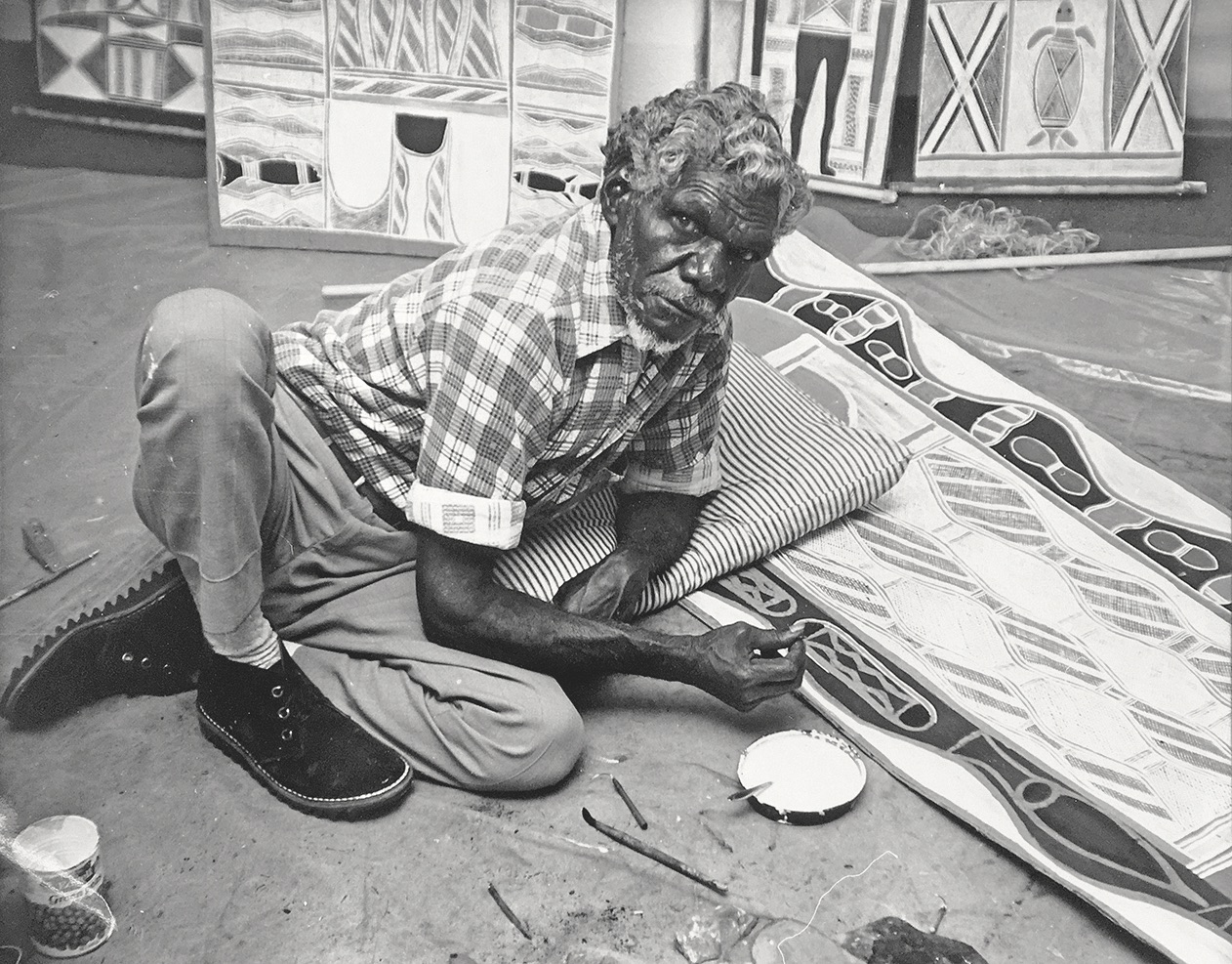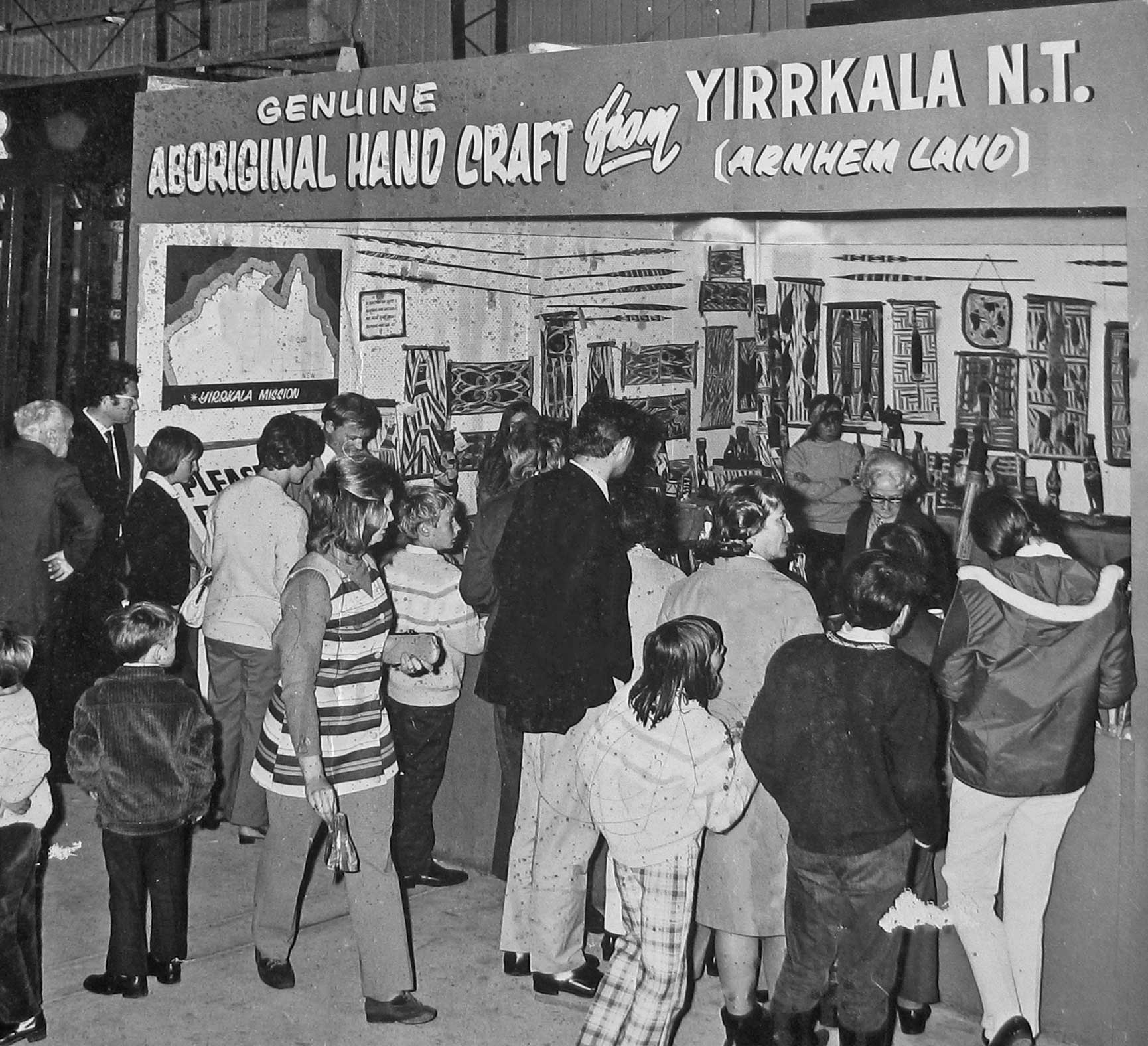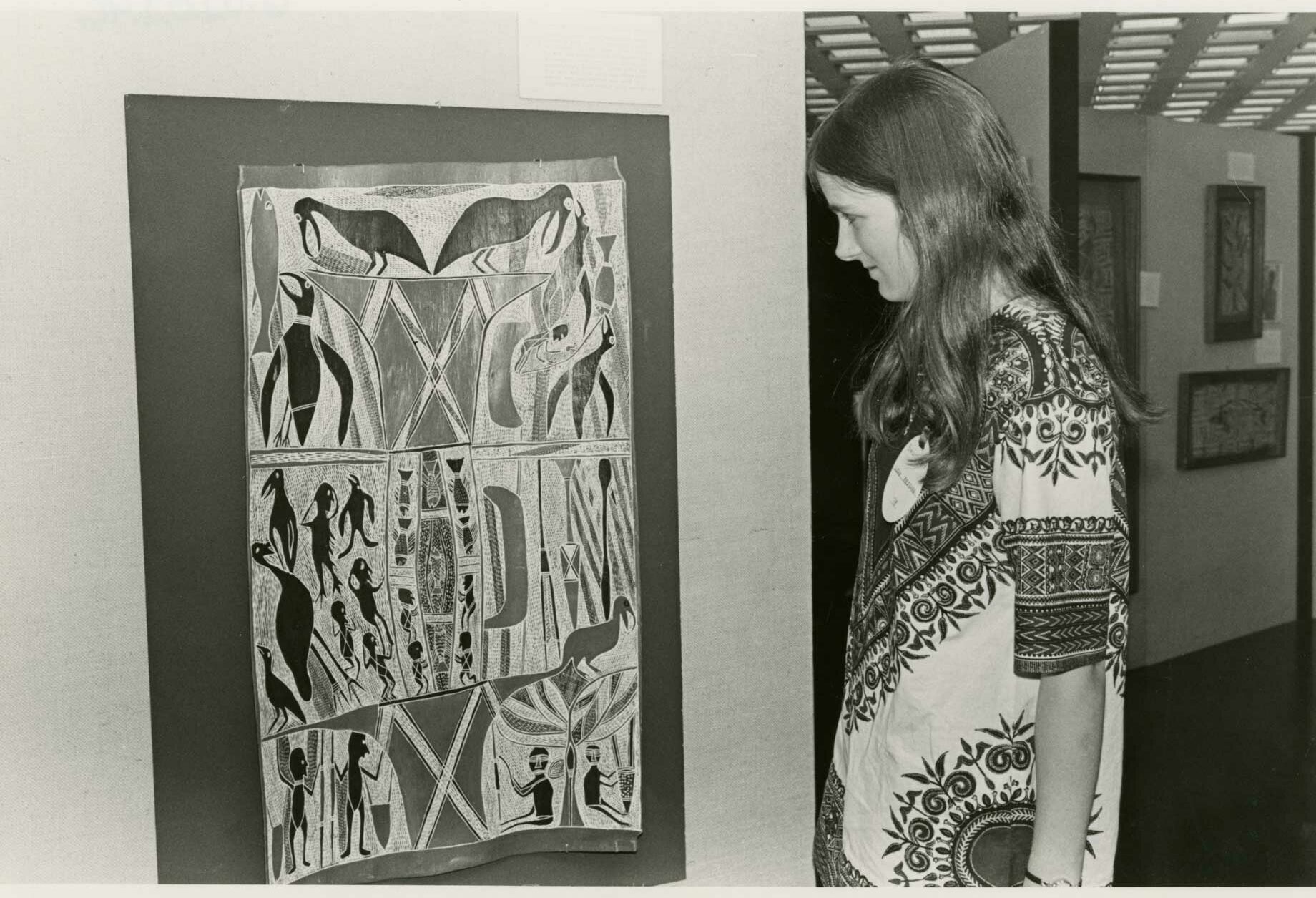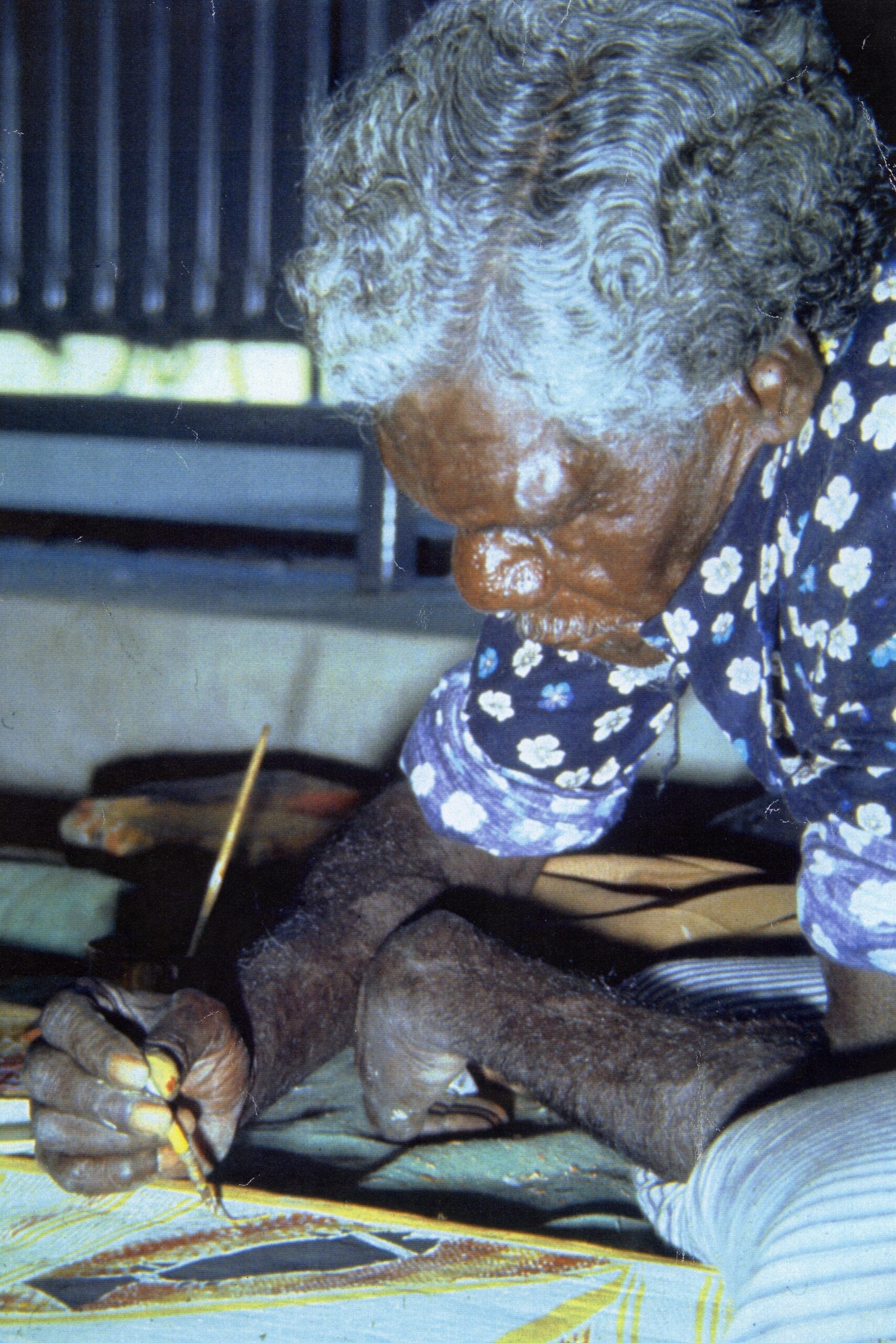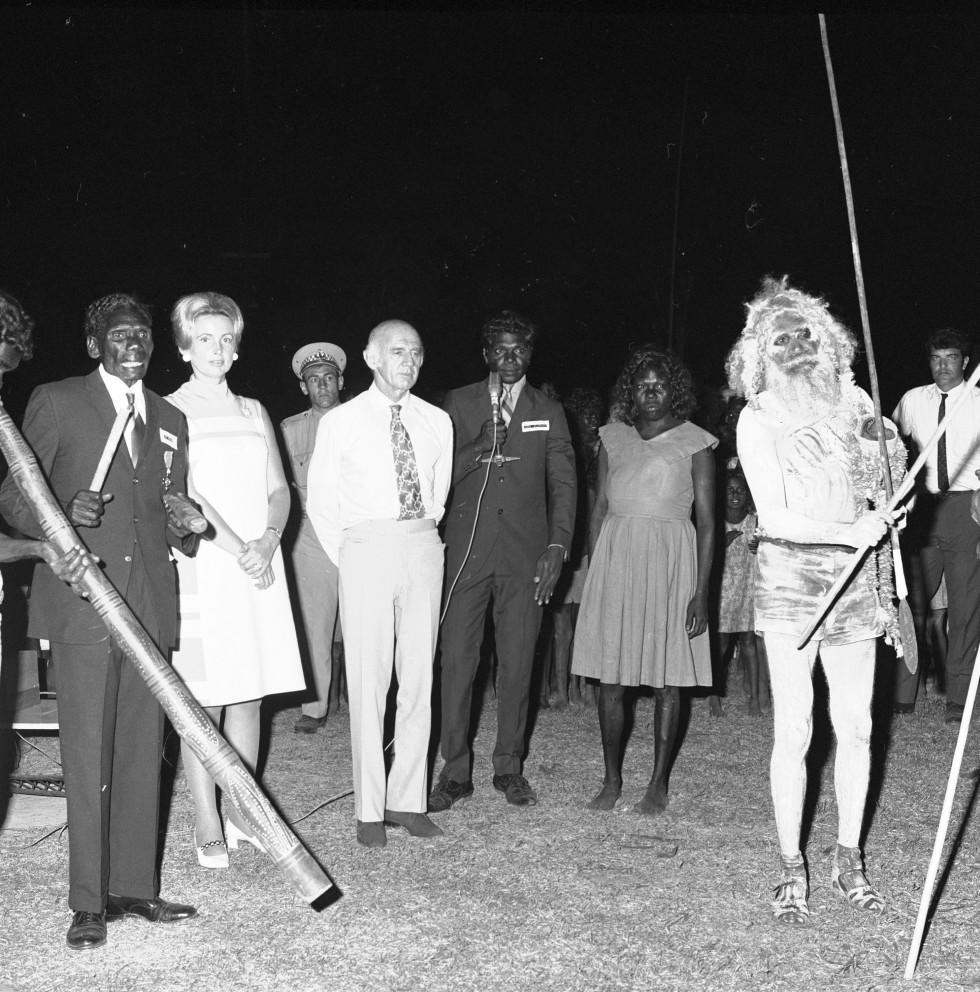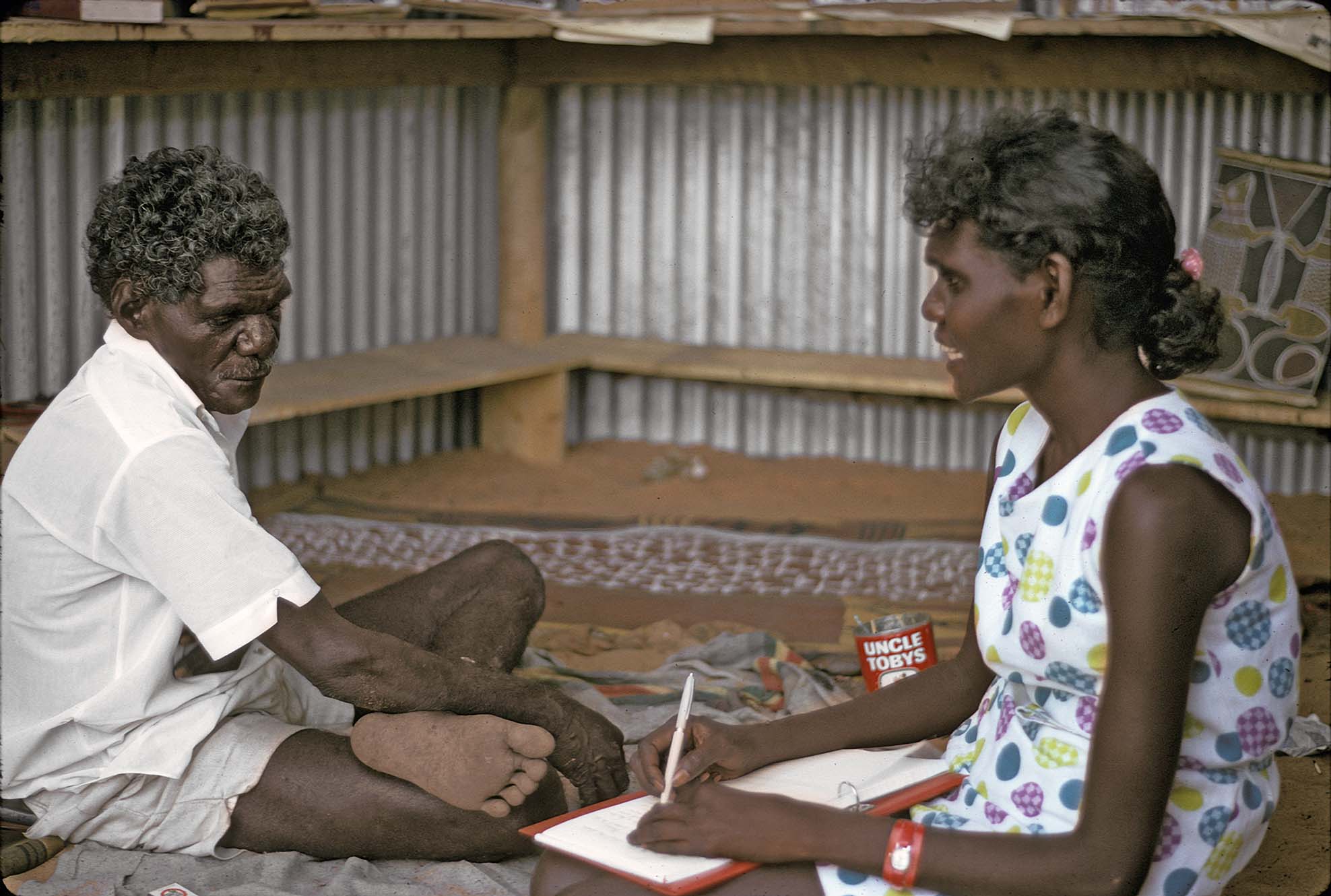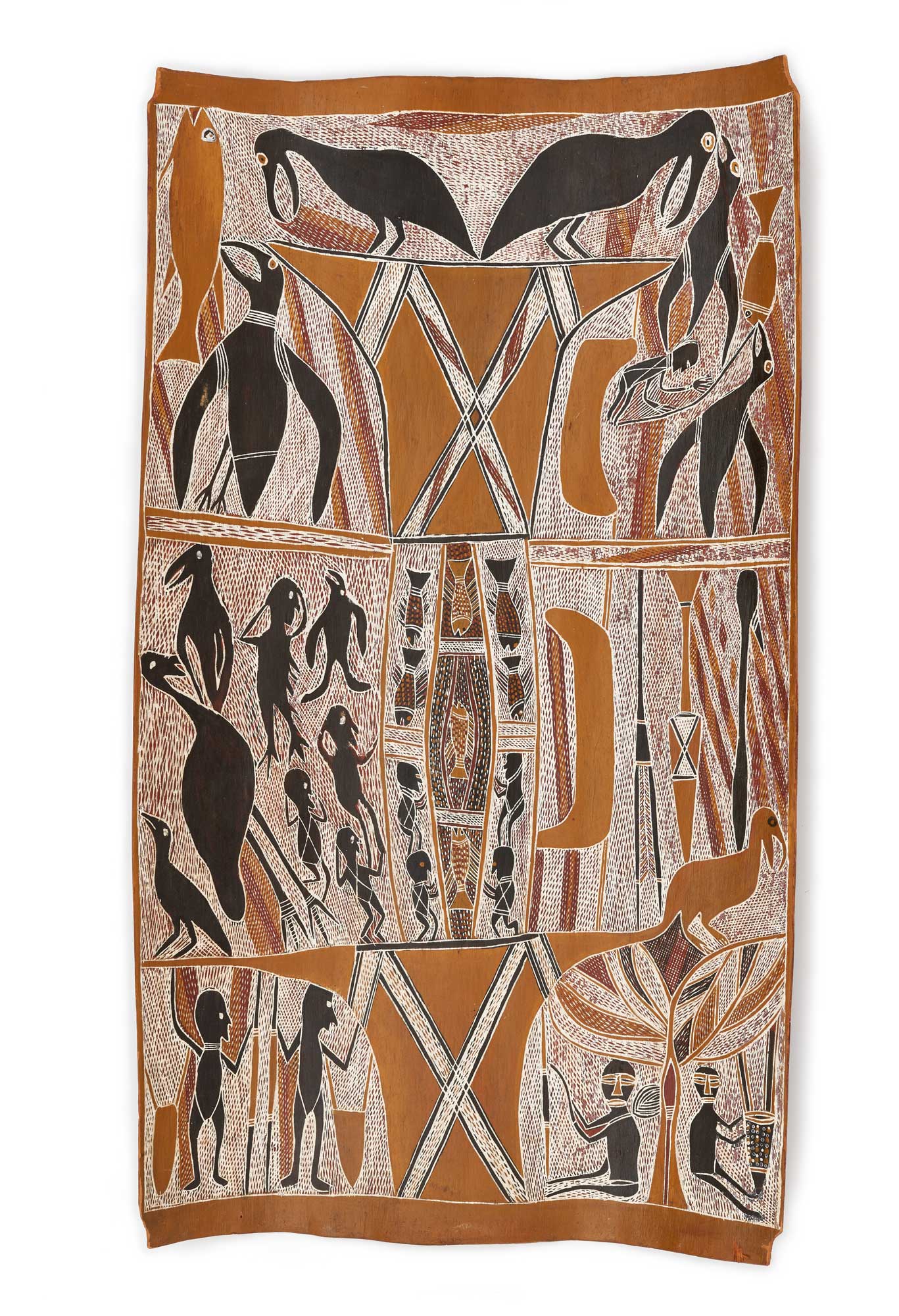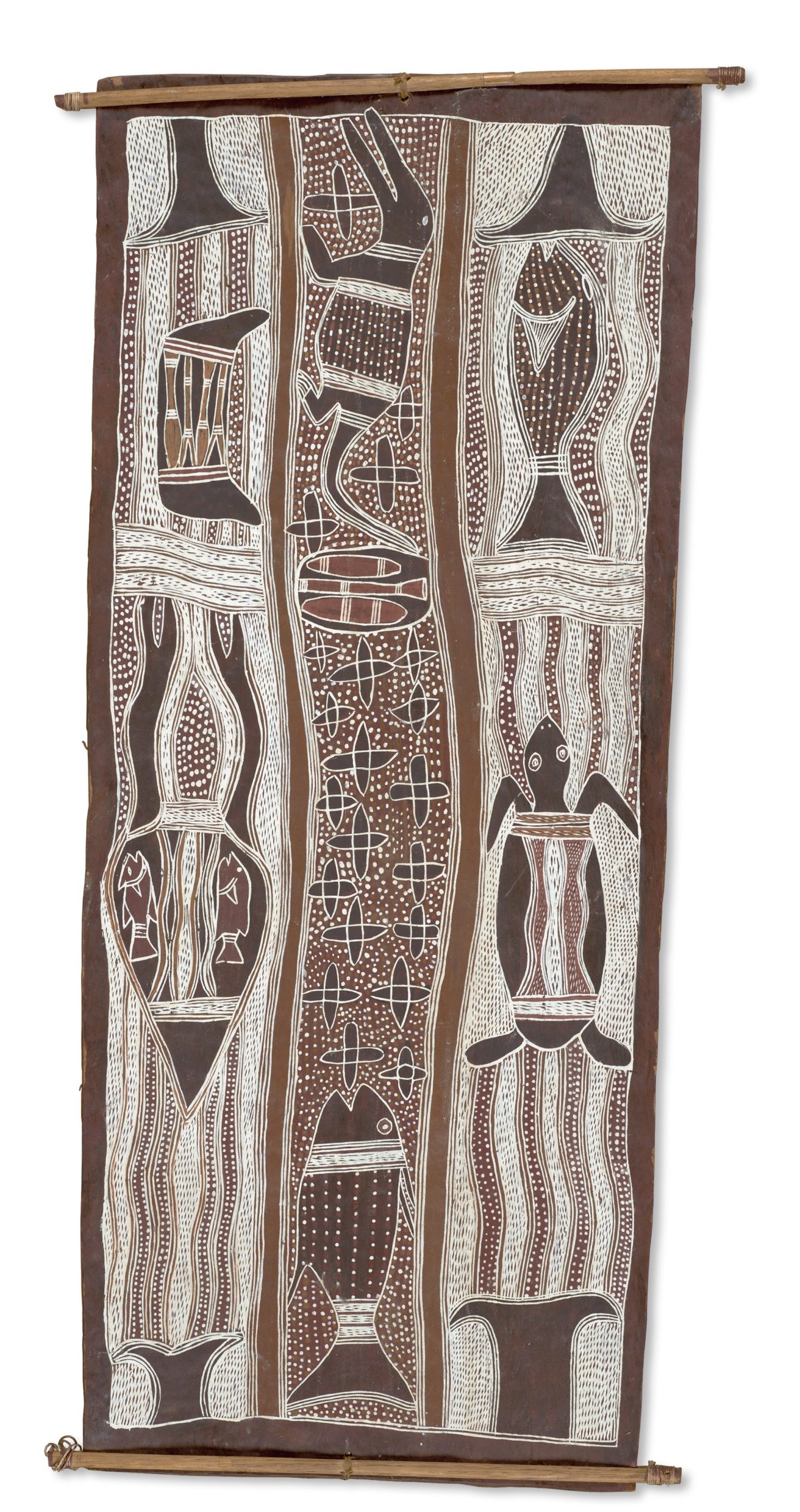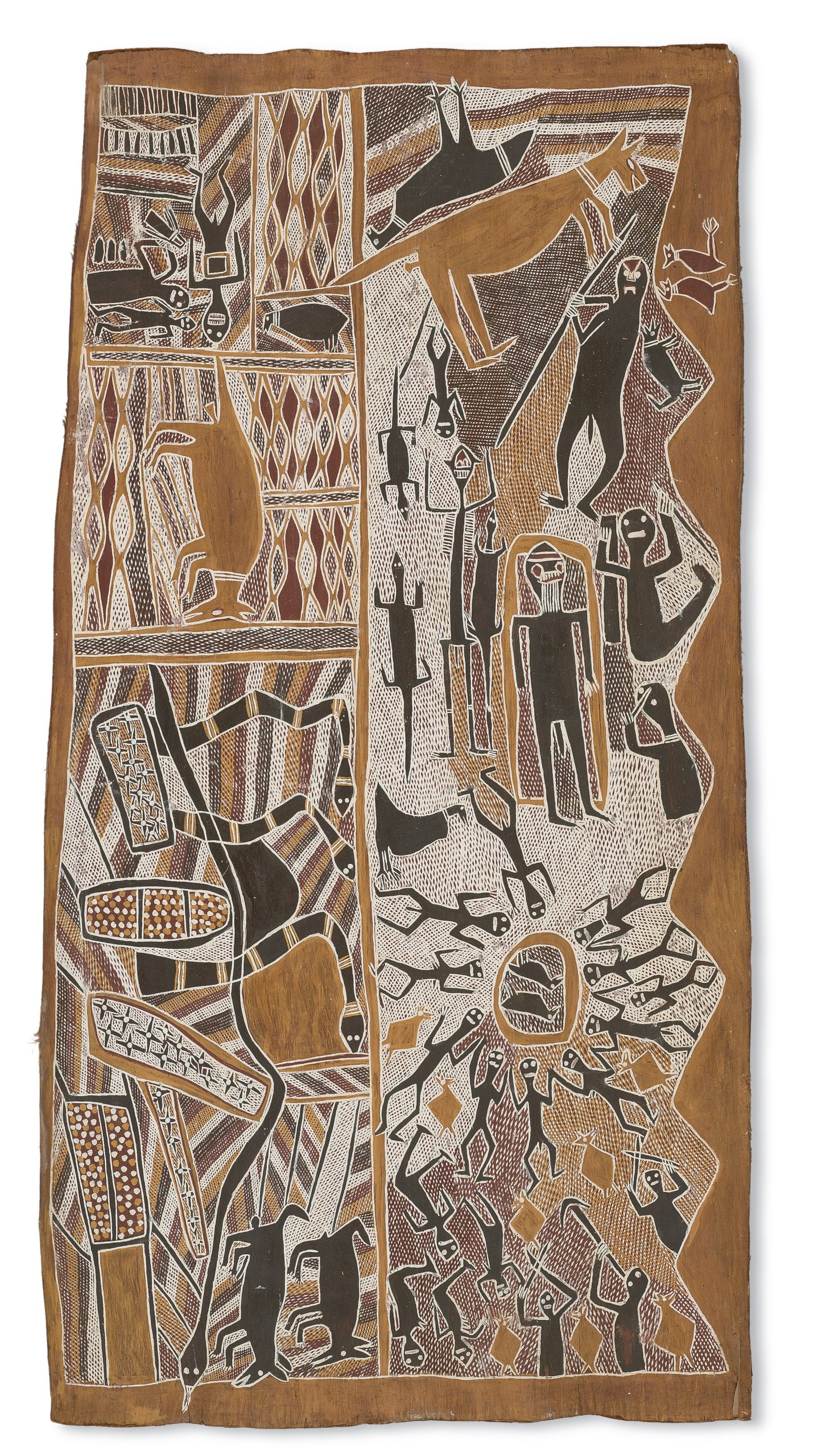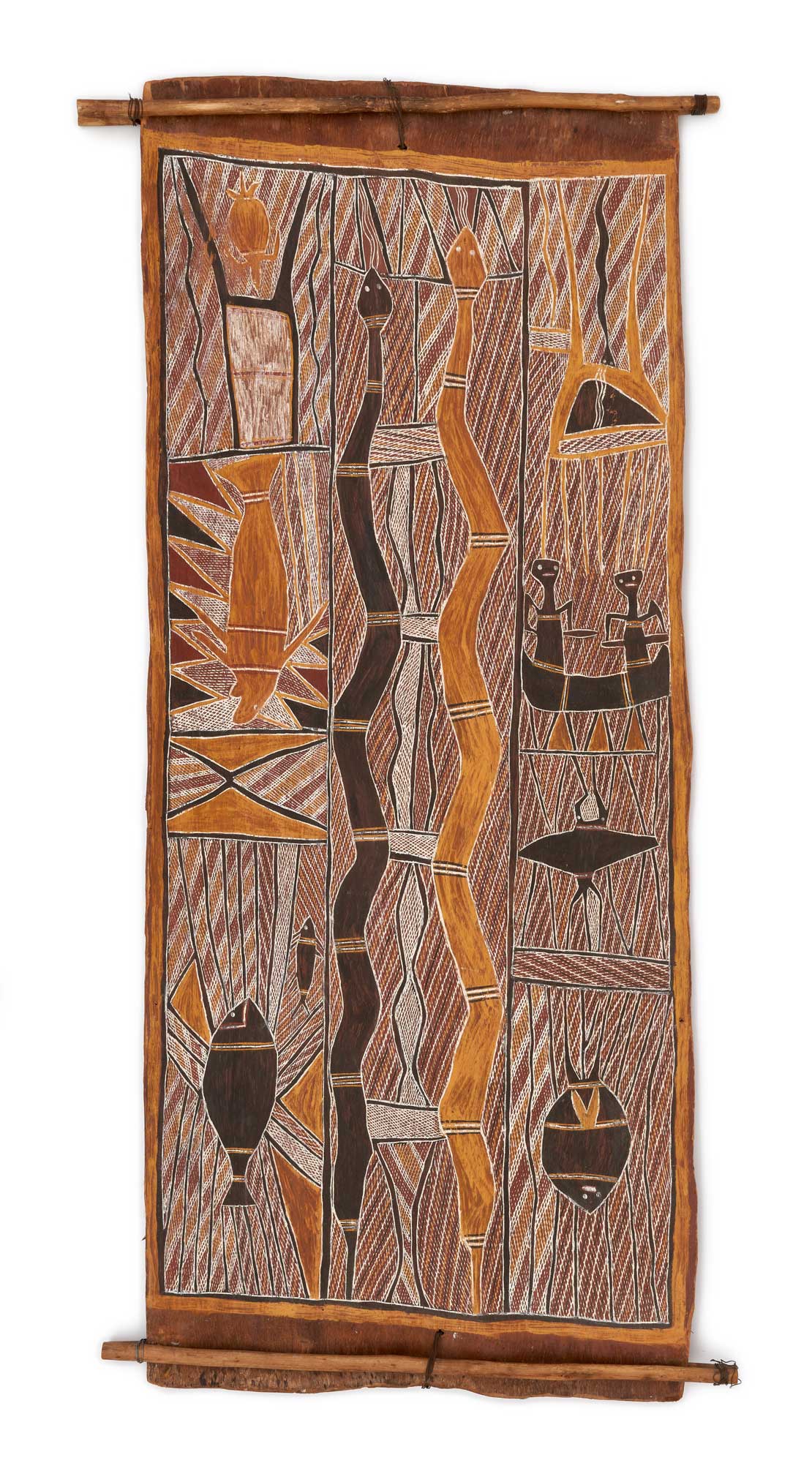1970s
After the hard-fought legal battles of the previous decade, the 1970s saw the first victories in the progress towards Yolŋu sovereignty. With the passing of the Land Rights Act of 1976, Yolŋu are finally recognized as the rightful owners of their ancestral lands. The same year, the Yirrkala Art and Craft Centre is established as an act of cultural self-determination. Yolŋu artists take to the world stage as the leaders of a confident new artistic movement.
1970
The Australian documentary filmmaker Ian Dunlop visits Yirrkala. This is the first of many visits to document the Yolŋu over the next 30 years, which results in the seminal Yirrkala Film Project.
The gross annual sale of art from Yirrkala increases between 1954 and 1970 from $291 USD (130 AUD) to $24,883 USD (22,217 AUD), according to Reverend Gordon Symons, chair of the North Australia District, Methodist Church of Australasia. A total of 66⁄% is paid to artists until 1964, increasing to 75% thereafter.
1971
Supplies arrive by ship at Yirrkala every three weeks. Additionally, barges arrive from Darwin every ten days. By the end of the 1970s, ships’ calls at Melville Bay from Brisbane are monthly, and air service is daily. Daily radio communication is also maintained with Darwin.
Narritjin Maymuru becomes one of the first Yolŋu artists to sell his own paintings and those of his family independently from the Yirrkala Mission store when he sets up a gallery outside of his home.
Edward L. Ruhe gives a pioneering donation of seven bark paintings to the Spencer Museum of Art, University of Kansas, Lawrence.
The Aboriginal Arts and Crafts Pty Ltd is established by the Department of Aboriginal Affairs to build a market for Aboriginal art. Wandjuk Marika serves as a director.
Roy Daḏayŋa Marika is appointed a Member of the Order of the British Empire (MBE).
Artists of Arnhem Land: An Exhibition of Australian Aboriginal Bark Paintings opens at the Kansas Union Gallery, University of Kansas, Lawrence.
1972
Prime Minister William McMahon and his wife, Sonia, visit Yirrkala.
Australian Aboriginal Art: Arnhem Land, an exhibition organized by Louis A. Allen, opens at the Field Museum of Natural History, Chicago.
1973
The Aboriginal Land Rights Commission investigates appropriate ways to recognize Aboriginal land rights in the Northern Territory. Chaired by Justice Edward Woodward, it becomes known as the Woodward Royal Commission into Aboriginal Land Rights (1973–74).
Masterpieces of Australian Bark Painting: An Exhibition of Aboriginal Art from Arnhem Land, organized by Edward L. Ruhe, opens at the University Art Gallery, State University of New York at Albany.
The Aboriginal Arts Board of the Australia Council is founded to provide for Indigenous control of public funding and policy in Aboriginal arts. In addition to supporting Indigenous-run art centers, the founding members, such as Wandjuk Marika, aim to promote interest in Aboriginal art through exhibitions, publications and gifts of works.
1974
The Northern Land Council and the Central Land Council are established as a result of recommendations originally made by the Aboriginal Land Rights Commission.
The anthropologists Frances and Howard Morphy begin their fieldwork at Yirrkala (1974–76). They establish close relationships with the Yolŋu that continue through today.
Dhuŋgala Munuŋgurr visits the Philippines and Papua New Guinea under a Methodist Overseas Mission–sponsored scheme of international travel for Yolŋu men in Arnhem Land in the 1960s and 1970s.
A new Methodist minister deinstalls the Yirrkala Church Panels mounted behind the altar of the church at Yirrkala.
The Yirrkala Mission ceases operations when the Methodist Church hands over control to the Yirrkala Dhanbul Community Association.
The Art of Aboriginal Australia, presented by Rothmans of Pall Mall Canada Ltd. under the sponsorship of the Aboriginal Arts Board, tours 13 venues in Canada between 1974 and 1976.
1975
Wandjuk Marika serves as the second chairman of the Aboriginal Arts Board (1975–79).
1976
The Aboriginal Land Rights (Northern Territory) Act is passed in response to recommendations made by the Woodward Royal Commission. Except for those areas covered by the mining lease, Yolŋu assume ownership of the majority of their lands under Australian law. It is the first attempt by the Australian government to legally recognize traditional landownership. The act accelerated the movement of Yolŋu back to their lands as part of the Homelands Movement.
The Yirrkala Art and Craft Centre is established by Yolŋu artists in the former mission health center. Chris McGuigan of the Aboriginal Arts Board is appointed the inaugural arts adviser (1976–77). He recruits Dhurryurrŋu Marika as his assistant.
A major exhibition of around 30 bark paintings and sculptures by artists from Yirrkala opens at the Walkabout Hotel, Nhulunbuy.
An Aboriginal delegation comprising Wandjuk Marika, Robert Yunupiŋu, Stan Roache, and Chicka Dixon travels to the United States for the American Bicentenary celebration. They visit Edward Ruhe at the University of Kansas, Lawrence, where The Bark Artists of Yirrkala opens at the Kansas Union Gallery in their honor.
Yirrkala Art: An Exhibition of Aboriginal Bark Paintings and Carvings, organized by the Department of Prehistory and Anthropology, opens at Australian National University, Canberra.
Australian Bark Paintings opens at the Beaumont Art Museum (now the Art Museum of Southeast Texas).
Art of the First Australians: An Exhibition of Aboriginal Painting, Sculpture and Artefacts of the Past Two Hundred Years opens at the Museum of Albuquerque, then travels to the Australian Embassy in Washington, DC, and to Houston.
1977
Chris McGuigan recruits Michael O’Ferrall to take over as arts adviser at the Yirrkala Art and Craft Centre (1977–79).
The Yirrkala Bark Petitions are put on public display at the Old Parliament House, Canberra. In 1988, they are moved to the new Parliament House.
1978
The Aboriginal Sacred Sites Authority is established following passage of the Aboriginal Sacred Sites Act in the Northern Territory. Later, the Northern Territory Aboriginal Sacred Sites Act of 1989 establishes the Aboriginal Areas Protection Authority.
Galarrwuy Yunupiŋu is named Australian of the Year.
David Burrumarra is made a Member of the Order of the British Empire (MBE).
Narritjin Maymuru and his son Banapana Maymuru are the first Aboriginal artists to be awarded the HC Coombs Creative Arts Fellowship at Australian National University, Canberra
During his HC Coombs Creative Arts Fellowship, Narritjin Maymuru becomes the first senior Yirrkala artist to experiment with printmaking. Yolŋu remain at the forefront of Indigenous engagement with printmaking.
Maŋgalili Art: Paintings by the Aboriginal Artists Narritjin and Banapana Maymuru opens at Australian National University, Canberra.
1979
Steve Fox takes over from Michael O’Ferrall as arts adviser at the Yirrkala Art and Craft Centre (1979–84). He works closely with Ralwurrandji Waṉambi, Yilila Munuŋgirritj, Yalmakany Marawili and Djikundurru Burarrwaŋa.
Wandjuk Djuwakan Marika is made an Officer of the Order of the British Empire (OBE).
The 3rd Biennale of Sydney includes work by bark painters from Raminginiŋ in Arnhem Land, including David Malaŋji, Djoni Buŋuwuy and George Milpurrurru.
